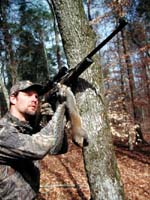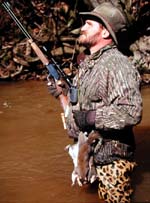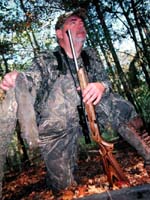
|
Features
|
|
|
|
Books
|
|
|
|
Fun & Games
|
|
|
|
Contact Us
|
|
|
John's Journal... Entry 215, Day 2
TRICKS IN THE TREETOPS
Location, Location, Location
 Editor's
Note: Regardless of how many years you've hunted squirrels, each season
you tend to forget some of the basics. You even may refuse to learn any
new skills, believing that you've always taken squirrels with the hunting
tactics you use.
Editor's
Note: Regardless of how many years you've hunted squirrels, each season
you tend to forget some of the basics. You even may refuse to learn any
new skills, believing that you've always taken squirrels with the hunting
tactics you use.
When you hunt the tricksters of the treetops, you must hunt in the most-productive places, since you'll find where you hunt far more critical to your success than how you hunt. Like a realtor explains the difference between the prices of two comparable houses, location makes one house more valuable than the other. The same applies to hunting areas. You'll find one hunting area more productive than another because of its location, its habitat and its utilization by squirrels. If you hunt where squirrels stay, you can have plenty of success in a short time. Some squirrel-hunting spots look like they should teem with bushytails, but for some reason, you won't find the squirrels there. I relearned this critical lesson of squirrel hunting. I didn't begin the morning hunt by stalking down the road. I started my hunt in what appeared to be a much better area than the thick cover on the edge of the woods road.
 "John,
the hardwoods in this bottom were full of squirrels this past fall," Toxey
Haas, the president of Mossy Oak camouflage from West Point, Mississippi,
told me. He'd let me off before daylight in mid-February near his hunting
camp close to Livingston, Alabama, since my home state of Alabama now
has a squirrel season that extends through February each year, allowing
families to hunt together after deer season ends. "I think all you have
to do is move quietly through the bottom from tree to tree to take a limit
of squirrels in an hour or two." On this day, I left Haas and silently
moved from the ridge to the hardwood bottom, awestruck at the beauty of
the virgin timber there. Never had I seen a more squirrely-looking place.
But after 45 minutes of hunting, I never saw a squirrel. I attempted to
analyze what had happened. I realized that with this many hardwoods producing
a tremendous number of acorns I should have pinpointed squirrels on every
limb of each tree. When I asked myself, "What's wrong?" I knew I needed
to forget about hunting squirrels and start looking for squirrel sign.
I realized I should find cut acorns or some other sign of squirrels feeding
to locate bushytails to hunt. I studied the ground in this hardwood bottom
and quickly realized that apparently at some time during the winter this
area had flooded. The water had washed all the mast crop from this prime
squirrel-hunting area. I couldn't find squirrels in a place with no food.
I returned to the ridges where I'd started my hunt and located squirrels
there.
"John,
the hardwoods in this bottom were full of squirrels this past fall," Toxey
Haas, the president of Mossy Oak camouflage from West Point, Mississippi,
told me. He'd let me off before daylight in mid-February near his hunting
camp close to Livingston, Alabama, since my home state of Alabama now
has a squirrel season that extends through February each year, allowing
families to hunt together after deer season ends. "I think all you have
to do is move quietly through the bottom from tree to tree to take a limit
of squirrels in an hour or two." On this day, I left Haas and silently
moved from the ridge to the hardwood bottom, awestruck at the beauty of
the virgin timber there. Never had I seen a more squirrely-looking place.
But after 45 minutes of hunting, I never saw a squirrel. I attempted to
analyze what had happened. I realized that with this many hardwoods producing
a tremendous number of acorns I should have pinpointed squirrels on every
limb of each tree. When I asked myself, "What's wrong?" I knew I needed
to forget about hunting squirrels and start looking for squirrel sign.
I realized I should find cut acorns or some other sign of squirrels feeding
to locate bushytails to hunt. I studied the ground in this hardwood bottom
and quickly realized that apparently at some time during the winter this
area had flooded. The water had washed all the mast crop from this prime
squirrel-hunting area. I couldn't find squirrels in a place with no food.
I returned to the ridges where I'd started my hunt and located squirrels
there.
 Often
you'll find more squirrels in shorter timber and thicker cover because
in big timber and river-bottom swamps predators like hawks, owls, foxes
and bobcats also can spot and take squirrels. Squirrels have the most
vulnerability in big, open hardwoods to the hunter -- both the two-legged
and four-legged kinds. In regions where predators can't see squirrels
as well and where the bushytails can dodge attacks from the air and the
ground by getting into thick cover, you'll generally discover the most
squirrels. Even in the late season when all the trees have lost their
leaves, the squirrels still will prefer the more brushy, shorter-timbered
sections rather than clear open hardwoods.
Often
you'll find more squirrels in shorter timber and thicker cover because
in big timber and river-bottom swamps predators like hawks, owls, foxes
and bobcats also can spot and take squirrels. Squirrels have the most
vulnerability in big, open hardwoods to the hunter -- both the two-legged
and four-legged kinds. In regions where predators can't see squirrels
as well and where the bushytails can dodge attacks from the air and the
ground by getting into thick cover, you'll generally discover the most
squirrels. Even in the late season when all the trees have lost their
leaves, the squirrels still will prefer the more brushy, shorter-timbered
sections rather than clear open hardwoods.
TOMORROW: SQUIRREL CALLING-USE MR. SQUIRREL
Check back each day this week for more about TRICKS IN THE TREETOPS ...
Day 1 - Stalk To Squirrels
Day 2 - Location, Location, Location
Day 3 - Squirrel Calling - Use Mr. Squirrel
Day 4 - Bark Them Out
Day 5 - The Cadillac of Squirrel Dogs